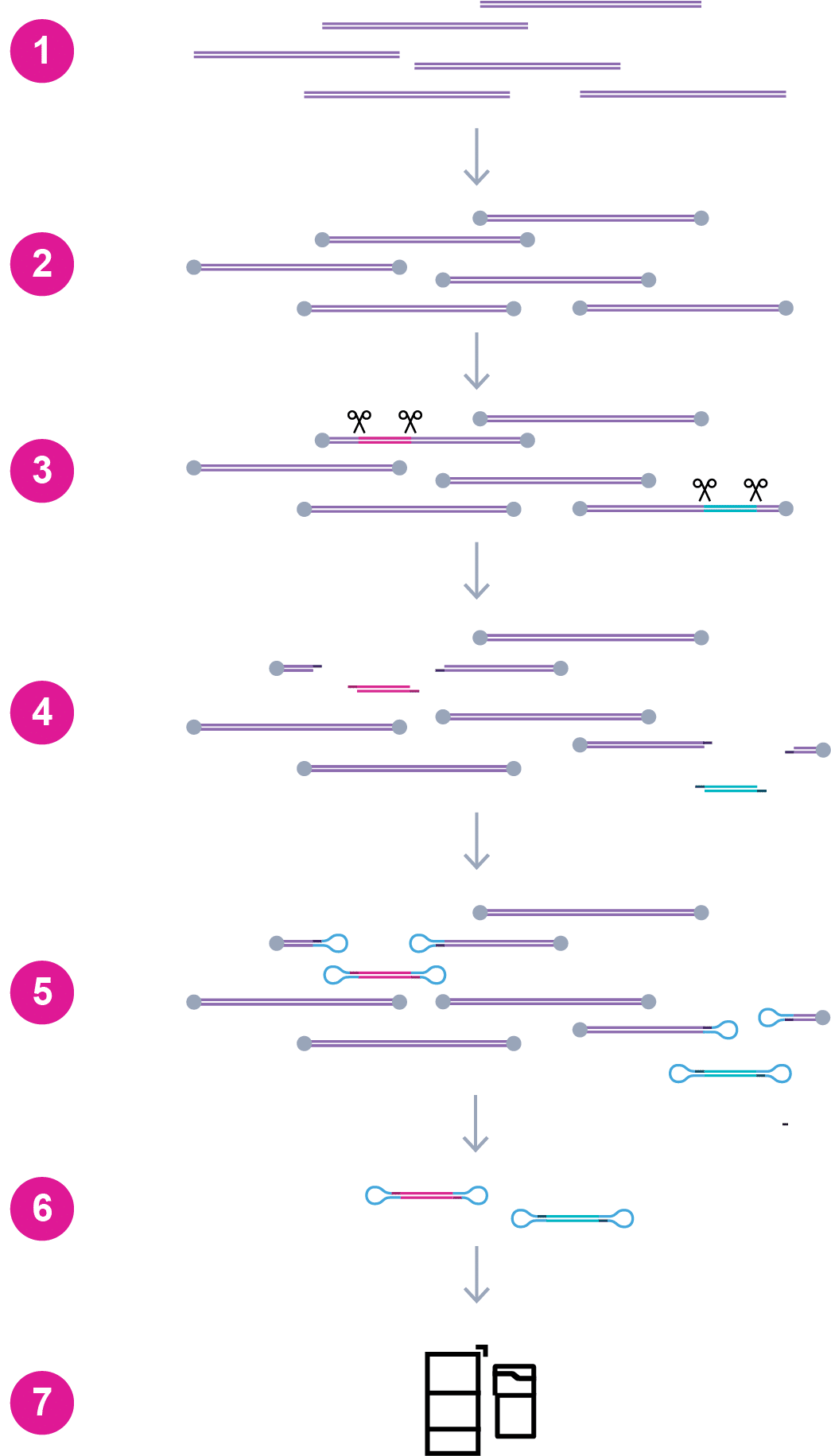WHAT IS PURETARGET?
- Convenient one-day library prep
- Low DNA input requirements (1-4 µg)
- Multiplex 48 samples per SMRT Cell on Vega and Revio and 24 samples per SMRT Cell on Sequel IIe
- High-quality long-read sequencing and methylation profiles
- Automated analysis of repeat size and methylation status for known pathogenetic repeats
PureTarget uses the CRISPR-Cas9 system to generate targeted native DNA libraries. This amplification-free approach retains epigenetic signals and has no PCR artifacts or errors.
With a streamlined workflow, multi-gene panels, and sample multiplexing, now you can screen the most challenging genomic regions at scale.
The PureTarget product line includes a panel of 20 repeat expansion loci relevant to neurodegenerative disease. Learn more about PureTarget-enabled comprehensive characterization of dark genes like FMR1, C9orf72 and RFC1.
View brochure View app note View blog View poster
How does it work?
- Start with high molecular weight DNA extracted from human blood or cell line with Nanobind kits
- Dephosphorylate to block DNA ends
- Cut DNA with Cas9 and pair of guide RNAs on each side of target
- Add dA tail
- Ligate indexed SMRTbell adapters
- Remove non-SMRTbell templates with nuclease digestion
- Pool and sequence 48 samples on the Revio system (24 samples on the Sequel IIe system)
Comprehensive genotyping with PureTarget repeat expansion panel and TRGT software

TRGT publication TRGT brochure Tandem repeat blog
PureTarget repeat expansion panel content
On-demand webinar
Characterizing C9ORF72 repeat expansions and transcripts using HiFi sequencing
Explore how the PureTarget repeat expansion panel offers comprehensive sequence information for pathogenic repeats, providing clarity where short reads and traditional methods may fall short.
Puretarget Datasets
PureTarget FAQs
The only supported sample type is human blood or cell line extracted with PanDNA or CBB kits. We have been successful internally and at customer sites using other human tissues and extraction kits. Please see our PureTarget app note for more details.
When using a sample type other than Nanobind-extracted human blood or cell line we recommend the following:
- First, demonstrate success using supported sample types, starting with an 8-plex and increasing sample quantity thereafter.
- Introduce new sample types or extraction methods in limited numbers, for example, 3 or fewer new sample types in an 8-plex of otherwise controls.
- See table 3 in the app note for more information about samples that are officially supported, have been tested, or are not recommended.
Non-human samples are untested and not supported as the guide RNAs used in the panel are designed for the human genome. With non-human samples, you can follow our suggestions on custom guide design. The region captured in the panel is available in Panel coordinate (XLSX).
The PureTarget 20 gene panel is at 5 µM and includes 20 pairs of gRNAs made up of 40 individual gRNAs at 0.125 µM each.
To add on custom genes to the panel, for simplicity, we recommend the following:
- Prepare your custom gRNAs pair per gene at final 5 µM.
- Spike into the PureTarget gRNA mix to prepare custom gRNA mixes prior to making ‘Reaction Mix 2 (RM2)’ in step 3 of the Procedure & checklist – Generating PureTarget repeat expansion panel libraries, while ensuring the total sum molarity of the final mix is 5 µM; the volumes of gRNAs you mix should be proportional to the number of guide pairs, for example add 2 µL of a 1-plex mix to 40 µL of the 20-plex PureTarget panel to keep the sum final molarity at 5 µM.
- Do not change any of the master mix volumes in the protocol.
Please consult with PacBio field application scientist or global service and support for more specific details on library prep
Custom PureParget panels are not supported by PacBio.
Custom PureTarget panels are not officially supported by PacBio. Users must design and order their guide RNAs and optimize their custom panels accordingly. PacBio can offer limited guidance on guide RNA design software and strategies for optimizing custom panels. We recommend first demonstrating success on the PureTarget repeat expansion panel using supported sample types before adding new guide RNAs or testing a custom set of guides.
Adding more validated repeat expansion targets: This “flavor” of customization is relatively low risk. Internally, we have demonstrated success in adding up to 5 pairs of guides for additional repeat expansion targets. The design strategy is the same as the fixed 20 gene panel: design guides ~2 kb upstream and downstream of the repeat expansion region with fragments ranging from 3-5 kb.
Adding non-repeat expansion targets: Internally, we have demonstrated success in adding a pair of guides to target a full-length gene with fragment size up to ~12 kb. Please consult with your field application bioinformatics support scientist for the recommended variant calling tools for your targets.
All other designs like capturing fragments longer than 12 kb or using a tiled design are untested and we do not have any recommendations on design or optimization.
A software tool we recommend for designing guide RNAs is Custom Alt-R CRISPR-Cas9 guide RNA from Integrated DNA Technologies (IDT) available here: https://www.idtdna.com/site/order/oligoentry/index/crisprcustom.
We recommend ordering SygRNAs (Synthetic Single Guide RNAs) from MilliporeSigma or sgRNA from IDT rather than the two-part targeting system composed of a separate tracrRNA and crRNA. This way, you only need to order one gRNA and the preparation is simplified (there is no annealing of the two molecules).

